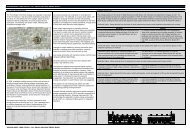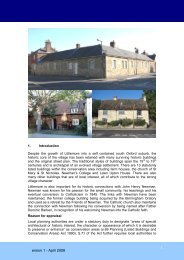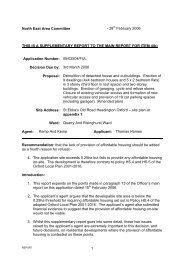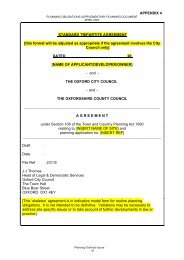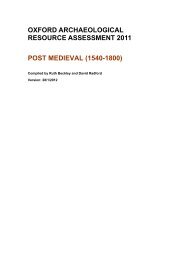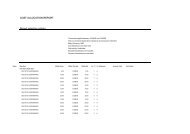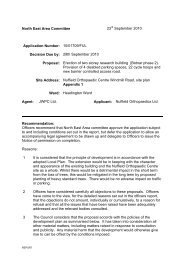Palaeolithic to Mesolithic Oxford (500000 - 4000 BC) - Oxford City ...
Palaeolithic to Mesolithic Oxford (500000 - 4000 BC) - Oxford City ...
Palaeolithic to Mesolithic Oxford (500000 - 4000 BC) - Oxford City ...
Create successful ePaper yourself
Turn your PDF publications into a flip-book with our unique Google optimized e-Paper software.
Chronology<br />
The <strong>Palaeolithic</strong> is traditionally considered <strong>to</strong> consist of three main periods: a Lower<br />
Middle and Upper <strong>Palaeolithic</strong>. Currently the earliest evidence of occupation in Britain<br />
during the Lower <strong>Palaeolithic</strong> dates <strong>to</strong> at least 700,000 years ago in East Anglia<br />
(Bar<strong>to</strong>n 2009, 19). No material of pre-Anglian age (MIS 12 and older) is currently<br />
recorded from the <strong>Oxford</strong> <strong>City</strong> district. Evidence from Suffolk indicates that the<br />
earliest human inhabitants of Britain migrated during warm climatic conditions with<br />
evidence of average summer temperatures of 18-23°C (Bar<strong>to</strong>n 2009 19). The<br />
majority of Lower/Middle <strong>Palaeolithic</strong> evidence for Britain dates <strong>to</strong> MIS 11-6 and most<br />
of the finds from the <strong>Oxford</strong> district date <strong>to</strong> this period. The British Late Middle<br />
<strong>Palaeolithic</strong> British Mousterian industry occurs during the earlier part of MIS 3 from<br />
about 60,000 years ago. As yet there does not seem <strong>to</strong> be evidence for this industry<br />
in the district (Hardaker 2007). The Upper <strong>Palaeolithic</strong> occurs during the later part of<br />
MIS 3 from about 40,000 years ago until the end of the period about 12,000<br />
calibrated years BP. In Britain this period is traditionally divided in<strong>to</strong> an Early Upper<br />
<strong>Palaeolithic</strong> and Late Upper <strong>Palaeolithic</strong>, separated by the extreme cold phase of the<br />
Last Glacial Maximum (LGM) about 21,000-19,000 years ago when humans appear<br />
<strong>to</strong> have been absent from the country. Late Upper <strong>Palaeolithic</strong> recolonisation of<br />
Britain following the LGM started about 16-15,000 calibrated years BP (Bar<strong>to</strong>n 2009).<br />
The Lower <strong>Palaeolithic</strong> context<br />
The lack of finds and features for the Lower-Middle <strong>Palaeolithic</strong> in the Upper Thames<br />
Valley in comparison <strong>to</strong> the Lower Thames Valley is notable and has been<br />
interpreted as being a result of <strong>Oxford</strong>shire being on the upper limit of human<br />
habitation at this time as well as some distance from good sources of flints (Roe<br />
1981; Roe 1994: 2). There are three main areas of Lower/Middle <strong>Palaeolithic</strong> artefact<br />
finds distribution in the county: 1) in the south east around Henley and Dorchester<br />
where the ancient gravel terraces have been particularly prolific 2) the Chiltern slopes<br />
at Benson and fan gravels at Wallingford and 3) the Upper Thames Valley north of<br />
the Goring Gap (Roe 1994: 5). Although the majority of Lower <strong>Palaeolithic</strong> artefacts<br />
in the Upper Thames Valley are recorded from gravel extraction sites there are also a<br />
number of single finds particularly from the <strong>Oxford</strong> area in correlation with the<br />
Summer<strong>to</strong>wn-Radley Gravel Formation. The majority of the artefacts discovered in<br />
<strong>Oxford</strong> are located on or immediately near <strong>to</strong> the terraces and are ‘rolled’ artefacts<br />
likely deposited as a result of fluvial action (Wymer 1968). Truly in-situ artefacts from<br />
the Lower/Middle <strong>Palaeolithic</strong> period in <strong>Oxford</strong>shire are very rare (Hardaker 2007).<br />
However the potential of the Wolvercote Gravel (Wolvercote Channel Deposit - see<br />
below) and the Summer<strong>to</strong>wn-Radley Gravel Formation (e.g. at Stan<strong>to</strong>n Harcourt and<br />
Berinsfield; Hardaker 2007) <strong>to</strong> preserve significant remains has been demonstrated.<br />
Key characteristics of the <strong>Oxford</strong> landscape in the Lower-Middle <strong>Palaeolithic</strong><br />
During the Pleis<strong>to</strong>cene each new glacial phase brought new superficial deposits and<br />
carved new pathways for the rivers and tributaries. The course of the river Thames<br />
itself underwent many changes primarily as a result of these glacial shifts, and it<br />
linked with continental river systems during cooler periods with low sea levels when<br />
England was connected <strong>to</strong> mainland Europe. Recent research has focused on<br />
attempting <strong>to</strong> reconstruct the ancient landscape of the Thames Valley through<br />
defining its relative elevations and the precise course of the river (Maddy et al. 1991;<br />
Bridgeland 1994; Robinson 2003).<br />
The potential for geo-archaeological sampling<br />
Geo-archaeological sampling can provide a stratigraphic framework for<br />
archaeological deposits and interpretations of site formation processes. In the case<br />
of development sites they can also assess the potential impact of development on<br />
OXFORD ARCHAEOLOGICAL RESOURCE ASSESSMENT- PALAEOLITHIC TO<br />
MESOLITHIC 6



